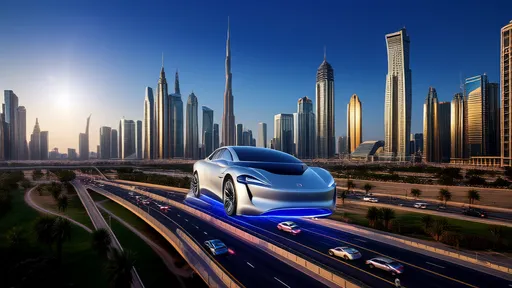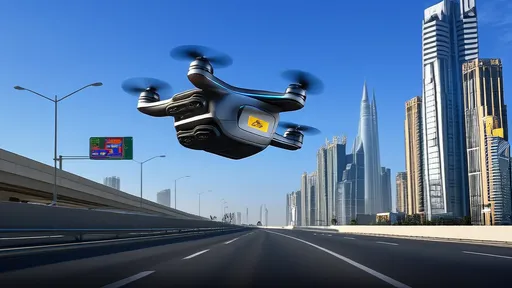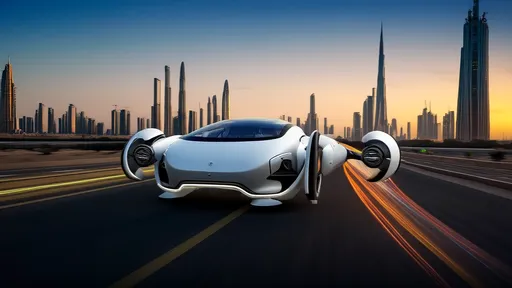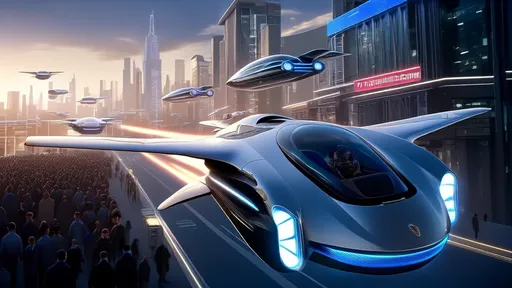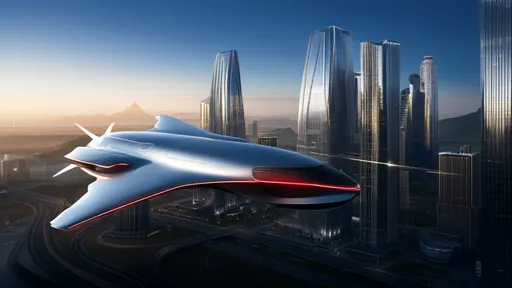The desert skies of the United Arab Emirates, long dominated by the sleek silhouettes of commercial airliners and private jets, are poised to welcome a new kind of vessel. In a landmark decision that signals a significant leap from science fiction to tangible reality, a specific model of flying car has been granted a special certificate of flight from the UAE's civil aviation authority. This is not merely a provisional test permit for a closed course; it is a crucial regulatory nod that brings the vision of urban air mobility one giant step closer to the daily lives of the region's residents.
The vehicle at the heart of this breakthrough is a marvel of modern engineering, a hybrid that blurs the line between automobile and aircraft. It boasts a sleek, aerodynamic design optimized for both road and air travel. On the ground, it functions as a conventional, albeit futuristic, electric car, capable of navigating city streets and highways with ease. With the push of a button, a stunning transformation occurs: wings unfold, rotors or propellers deploy, and the vehicle transitions into a compact, vertical take-off and landing (VTOL) aircraft. This dual-mode capability is the cornerstone of its practicality, eliminating the need for traditional runways and allowing it to operate from designated vertiports, helipads, or even suitably equipped rooftops.
For the UAE, a federation renowned for its audacious architectural projects and its relentless pursuit of becoming a global hub for innovation, this development is a strategic masterstroke. The nation's leadership has consistently demonstrated a forward-thinking approach to transportation and technology. Embracing flying cars aligns perfectly with this vision, offering a potential solution to the perennial issue of urban congestion in metropolises like Dubai and Abu Dhabi. The infamous traffic snarls that can gridlock the city's sprawling networks of highways could, in the not-too-distant future, be bypassed entirely by taking to the skies. This initiative is seen as a key component in building the smart, hyper-connected cities of the future, reinforcing the UAE's image as a living laboratory for next-generation technology.
The path to this certification was neither swift nor simple. It involved years of rigorous testing, meticulous safety evaluations, and close collaboration between the manufacturer and the UAE's General Civil Aviation Authority (GCAA). The GCAA, known for its stringent international standards, subjected the vehicle to a battery of tests far beyond what a typical automobile or even a nascent aircraft might face. Engineers scrutinized its structural integrity during the complex transition from car to plane. They tested its performance under a vast range of atmospheric conditions, from the blistering heat of the desert summer to the occasional gusty winds. Redundancy was a key focus; every critical system, from flight controls and power delivery to navigation, features multiple backups to ensure safety in the event of a component failure. The granting of this certificate is a powerful testament that the authorities are satisfied, for this specific phase of operation, that the vehicle meets an acceptable and defined level of airworthiness.
This regulatory approval opens the door to a carefully managed, phased implementation. The initial phase will likely involve limited, pre-defined routes for specific use cases. Imagine a high-priority executive being whisked from the rooftop of a downtown Dubai skyscraper directly to the tarmac of Al Maktoum International Airport in a fraction of the current travel time. Or consider the potential for emergency medical services, where a flying car could transport a specialist or vital supplies across the city, unimpeded by terrestrial obstacles. These targeted applications will serve as a critical proof-of-concept, allowing regulators, operators, and the public to build confidence in the technology's safety, reliability, and operational protocols in a controlled environment.
However, the journey from this initial certification to a sky filled with commuter vehicles is fraught with complex challenges that extend far beyond the technology itself. The most significant hurdle is the creation of a comprehensive and robust regulatory framework. The skies above our cities are a complex tapestry of controlled airspace, and integrating a potentially large number of low-altitude, piloted or eventually autonomous vehicles is a monumental task. Authorities will need to develop entirely new air traffic management systems, often referred to as U-Space or UTM (Unmanned Traffic Management), capable of preventing mid-air collisions and managing the flow of aerial vehicles with the same precision as current systems handle commercial aviation.
Public acceptance is another critical pillar for success. The concept of flying cars, while exciting, also invokes concerns about noise pollution, privacy, and, most importantly, safety. The sound of multiple VTOL vehicles taking off and landing in urban canyons must be mitigated to avoid creating a new form of nuisance. People will need assurance that these vehicles are not prone to falling out of the sky, that their data is secure, and that their right to privacy is respected. Manufacturers and regulators will have to engage in a sustained and transparent public education campaign to address these legitimate concerns and build the social license necessary for this new mode of transport to thrive.
The economic implications of this new industry are profound. The UAE's early adoption positions it as a potential global leader in the urban air mobility ecosystem. This extends far beyond simply being an early market for the vehicles themselves. It encompasses the entire value chain: the development and construction of a network of vertiports, the creation of maintenance and repair facilities, the training and certification of pilots (and eventually, AI operators), and the software platforms that will power the booking and management of flights. By establishing a clear and supportive regulatory environment now, the UAE is sending a powerful signal to investors and entrepreneurs worldwide, inviting them to build the supporting industries of this new aerial economy within its borders.
Looking beyond the immediate horizon, the successful integration of flying cars could fundamentally reshape the urban landscape and our very conception of distance and time. The notorious one-hour commute could be reduced to a ten-minute aerial journey. This has the potential to alter real estate dynamics, as living further from a city center becomes less of a logistical penalty. The design of new buildings and districts will increasingly incorporate aerial mobility as a core utility, much like fiber-optic internet is today. Rooftop vertiports could become as standard a feature in new skyscrapers as underground parking garages.
The UAE's granting of a special flight certificate for a flying car is far more than a publicity stunt or a novelty. It is a decisive and calculated move that marks a pivotal moment in the history of transportation. It demonstrates that a major national government, with a world-class aviation authority, believes the technology has matured to a point where real-world, regulated operation is not just possible, but imminent. While the sight of a flying car silently ascending from a city street may still turn heads today, the UAE has set in motion a process aimed at making that sight as mundane as hailing a taxi in just a few years' time. The race to define the future of urban mobility is officially airborne, and the United Arab Emirates has just secured a commanding lead.
The once-fantastical vision of humanoid robots, long confined to the pages of science fiction and the silver screen, is steadily materializing into a tangible engineering reality. This evolution is not the result of a single, monumental breakthrough but rather a profound and intricate symphony of advancements across a multitude of scientific and engineering disciplines. The quest to create machines that not only look but also move, perceive, and interact with the fluidity and adaptability of humans represents one of the most ambitious technological endeavors of our time. It is a grand convergence, where progress in artificial intelligence, materials science, mechanical engineering, and cognitive science coalesces to breathe life into metal and silicon, pushing the boundaries of biomimicry to unprecedented heights.
The recent inclusion of humanoid robots in the 2025 Top Ten Global Engineering Achievements marks a watershed moment in technological history. This recognition transcends mere academic acknowledgment; it represents a collective global validation of decades of research, development, and iterative innovation in robotics. For years, humanoid robots existed primarily in the realms of science fiction and laboratory prototypes, often viewed as fascinating but distant curiosities. Their elevation to a top global engineering feat signals a profound shift—a transition from conceptual marvels to tangible agents of change poised to reshape our societal and industrial landscapes.
In a landmark recognition of human engineering prowess, China's full-ocean-depth manned submersible has been selected among the 2025 Top Ten Global Engineering Achievements, standing shoulder-to-shoulder with revolutionary projects like quantum computing infrastructure and Mars colonization prototypes. This prestigious listing, announced by the International Engineering Consortium earlier this morning, represents more than just technological acknowledgment—it signifies humanity's renewed commitment to conquering Earth's final frontier.
In the heart of Dubai's morning rush hour, the familiar gridlock of Sheikh Zayed Road stretches for kilometers below, but above the shimmering asphalt, a new dimension of transportation is quietly rewriting the rules of urban mobility. As first reported by The Times of India, the city's ambitious flying car initiative has transitioned from futuristic concept to operational reality, with commuters now gliding between skyscrapers in electric vertical take-off and landing vehicles. This isn't a scene from a science fiction film but the new daily reality for a growing number of Dubai residents who have traded their terrestrial commutes for the freedom of three-dimensional travel.
The desert skies of the United Arab Emirates, long dominated by the sleek silhouettes of commercial airliners and private jets, are poised to welcome a new kind of vessel. In a landmark decision that signals a significant leap from science fiction to tangible reality, a specific model of flying car has been granted a special certificate of flight from the UAE's civil aviation authority. This is not merely a provisional test permit for a closed course; it is a crucial regulatory nod that brings the vision of urban air mobility one giant step closer to the daily lives of the region's residents.
In a move signaling a new era of technological collaboration, Southeast Asian nations and the United States are forging a groundbreaking partnership in artificial intelligence development. This strategic alliance emerges at a critical juncture when global AI governance remains fragmented and the technology's potential to reshape economies and societies becomes increasingly apparent. The collaboration represents more than just technical cooperation—it embodies a shared vision for responsible innovation that respects cultural diversity while addressing common challenges.
The Euclid Space Telescope, humanity's newest and most ambitious eye on the cosmos, has begun its monumental mission to pierce the profound darkness that envelops our universe. Launched into the silence beyond our atmosphere, its purpose is not merely to capture stunning celestial portraits but to map the invisible architecture of reality itself. For decades, astronomers have known that the cosmos we see—the glittering tapestry of stars, galaxies, and nebulae—comprises a mere five percent of the total content of the universe. The remaining ninety-five percent is a profound mystery, a dual enigma composed of dark matter and dark energy. These are the phantoms of physics, entities that do not emit, absorb, or reflect light, yet whose gravitational influence dictates the fate of everything we hold visible. Euclid is our most sophisticated attempt to date to bring these shadows into the light, to understand the hidden forces that have shaped the universe's past and will determine its ultimate destiny.
Beijing's National Stadium, once the iconic centerpiece of the 2008 Summer Olympics, echoed with a different kind of applause this week. The thunderous cheers were not for human athletes pushing the limits of physical endurance, but for their mechanical counterparts—humanoid robots competing in the inaugural World Humanoid Robot Sports Games. The air, thick with the whirring of servos and the collective anticipation of engineers and spectators, marked a pivotal moment in the history of robotics and international sport.
The landscape of oncology treatment is undergoing a profound transformation, driven by the emergence of third-generation antibody-drug conjugates (ADCs). These sophisticated therapeutic agents represent a significant leap forward in the quest for precision medicine, offering new hope for patients battling various forms of cancer. Unlike conventional chemotherapy that attacks both healthy and cancerous cells indiscriminately, these advanced biologics deliver potent cytotoxic agents directly to tumor cells, minimizing damage to healthy tissues and reducing debilitating side effects.
In the relentless battle against cancer, a revolutionary class of therapeutics has emerged, earning the evocative moniker of "precision missiles" for their ability to deliver potent cytotoxic agents directly to malignant cells while sparing healthy tissue. These are Antibody-Drug Conjugates, or ADCs, and they represent a sophisticated fusion of biologic targeting and potent chemotherapy, a paradigm shift in oncology that is redefining treatment expectations for a growing number of cancers.
The desert skies above Dubai witnessed a historic moment last week as the sleek silhouette of a flying car cut through the cerulean blue, marking what many industry experts are calling the dawn of a new era in personal transportation. The demonstration, orchestrated by the pioneering aviation firm AeroMobil Emirates, was not merely a test flight; it was a powerful statement of intent, a tangible promise of a future once confined to the pages of science fiction.
In a remarkable demonstration of growing consumer confidence in aerial mobility solutions, global pre-orders for flying cars have surged past the 7,000-unit milestone. This significant threshold, reached far earlier than most industry analysts had projected, signals a fundamental shift in public perception about the viability of personal air transportation. What was once confined to science fiction novels and futuristic concept videos is rapidly transforming into a tangible consumer product category with demonstrated market demand.
In the shimmering heat of the Arabian Gulf, a new silhouette is beginning to pierce the horizon. It is not the familiar form of a commercial airliner nor the sleek profile of a private jet, but something altogether more futuristic—a flying car. This vision, once confined to the realms of science fiction, is fast becoming a tangible reality, and it is Chinese innovation that is poised to turn the skies above Dubai, Abu Dhabi, and Riyadh into a dazzling new theater of urban mobility.
The relentless march of artificial intelligence demands computational power on a scale previously unimaginable. At the heart of this revolution lies the Graphics Processing Unit, or GPU, which has evolved from a specialized graphics rendering component into the primary engine for AI workloads. The latest generation of GPU architectures represents a paradigm shift, not merely an incremental improvement. These new designs are fundamentally re-engineering the silicon to tackle the unique and colossal demands of modern AI, with a core focus on achieving unprecedented levels of computational density and efficiency through hyper-scale integration.
The ASEAN-US AI Cooperation Forum concluded its third annual session this week with a renewed commitment to bridging the digital divide through focused capacity building and infrastructure development. Held against the backdrop of rapid technological advancement, the forum brought together policymakers, industry leaders, and academics to chart a collaborative path forward, recognizing that the benefits of artificial intelligence must be distributed equitably to ensure regional stability and prosperity.



